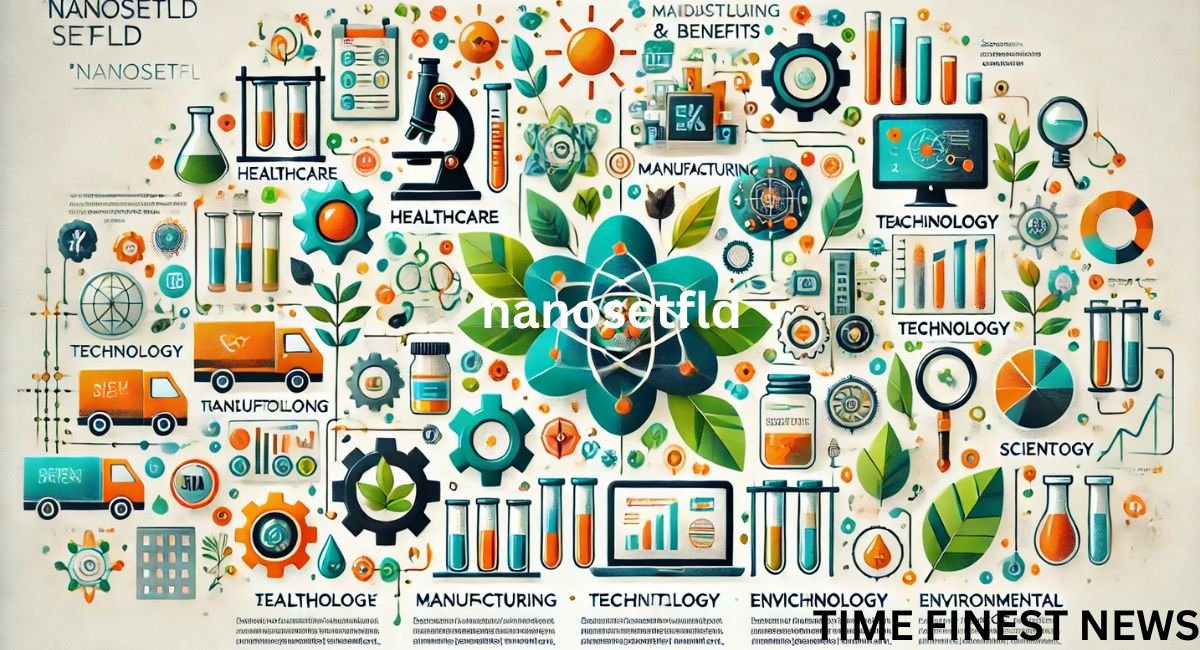Exploring Nanosetfld: The Frontier of Nanotechnology

Introduction to Nanosetfld
Nanosetfld represents a cutting-edge advancement in the field of nanotechnology, characterized by its unique applications and versatile functionality. As the world becomes increasingly reliant on precise and efficient technologies, Nanosetfld has emerged as a significant player in various sectors, offering innovative solutions that enhance product performance and efficiency. This article provides an in-depth exploration of Nanosetfld, examining its core features, applications, benefits, and future prospects.
Historical Context and Development
The development of Nanosetfld is rooted in the broader evolution of nanotechnology, a field that manipulates matter at the atomic and molecular scale. The journey began with foundational research in the late 20th century, focusing on the manipulation of materials at the nanoscale. Over the years, advancements in material science, chemistry, and engineering have paved the way for the creation of Nanosetfld. This technology embodies the convergence of these disciplines, resulting in a versatile tool that can be applied across multiple industries.
Core Components and Mechanisms
Nanosetfld is distinguished by its unique structure and operational principles. At its core, Nanosetfld consists of nanoscale components designed to interact with materials and systems at a microscopic level. These components can include nanoparticles, nanocoatings, and nanostructured materials, each contributing to the overall functionality of the technology. The mechanisms by which Nanosetfld operates often involve the manipulation of physical and chemical properties at the nanoscale, leading to enhanced performance characteristics such as increased strength, conductivity, or reactivity.
Applications Across Various Industries
The versatility of Nanosetfld is evident in its wide range of applications across different industries:
- Healthcare: In medicine, Nanosetfld is used for targeted drug delivery, diagnostics, and the development of advanced biomaterials. Its ability to interact with biological systems at the cellular level makes it invaluable for creating more effective treatments and medical devices.
- Electronics: Nanosetfld plays a crucial role in the development of next-generation electronic devices, including semiconductors, sensors, and display technologies. Its nanoscale precision enables the creation of components that are smaller, faster, and more energy-efficient.
- Materials Science: In materials science, Nanosetfld is used to enhance the properties of materials, such as increasing their strength, durability, and thermal stability. This has applications in industries ranging from aerospace to construction.
Advantages and Benefits of Nanosetfld
The use of Nanosetfld offers numerous benefits, including:
- Enhanced Performance: By operating at the nanoscale, Nanosetfld can significantly enhance the properties of materials and systems, leading to improved performance in various applications.
- Precision and Efficiency: The nanoscale precision of Nanosetfld allows for more efficient processes and systems, reducing waste and energy consumption.
- Innovation Potential: Nanosetfld enables the development of new products and technologies that were previously unattainable, driving innovation across multiple industries.
Challenges and Limitations
Despite its promising potential, Nanosetfld also faces several challenges and limitations. One of the primary challenges is the complexity of manufacturing and integrating nanoscale components, which can be costly and require specialized equipment. Additionally, there are concerns about the long-term safety and environmental impact of nanomaterials, necessitating comprehensive risk assessments and regulatory oversight. Addressing these challenges requires ongoing research and collaboration among scientists, engineers, and policymakers.
Technological Innovations and Advancements
The field of Nanosetfld is continually evolving, with recent innovations enhancing its capabilities and expanding its applications. Advances in nanofabrication techniques, such as lithography and self-assembly, have improved the precision and scalability of Nanosetfld production. Furthermore, the integration of Nanosetfld with other emerging technologies, such as artificial intelligence and machine learning, is opening new avenues for smart materials and responsive systems.
Global Adoption and Trends
Nanosetfld is gaining traction worldwide, with significant investments in research and development from both public and private sectors. Countries with advanced technological infrastructures, such as the United States, China, and Germany, are leading in the adoption and commercialization of Nanosetfld technologies. The global market for nanotechnology is expected to grow substantially, driven by increasing demand in sectors such as healthcare, electronics, and energy.
Security and Ethical Considerations
As with any advanced technology, the use of Nanosetfld raises important security and ethical considerations. The potential for unintended consequences, such as environmental harm or health risks, requires careful monitoring and regulation. Additionally, ethical issues related to the use of nanotechnology in medicine and other sensitive areas must be addressed, including concerns about privacy, consent, and equitable access. It is essential to develop robust frameworks for ethical governance and public engagement to ensure responsible development and deployment of Nanosetfld.
Future Prospects and Emerging Trends
The future of Nanosetfld is bright, with numerous emerging trends poised to shape its development. One key trend is the convergence of nanotechnology with biotechnology, leading to breakthroughs in personalized medicine and regenerative therapies. Another trend is the increasing focus on sustainable nanotechnology, aimed at minimizing the environmental footprint of nanomaterial production and use. As research and development continue, we can expect to see more innovative applications of Nanosetfld that address global challenges and improve quality of life.
Case Studies: Successful Implementations
Several case studies highlight the successful implementation of Nanosetfld in various industries:
- Healthcare: A pharmaceutical company utilized Nanosetfld to develop a targeted drug delivery system that enhances the efficacy of cancer treatments while minimizing side effects. This innovation has led to better patient outcomes and reduced treatment costs.
- Electronics: An electronics manufacturer integrated Nanosetfld into its semiconductor production process, resulting in smaller, faster, and more energy-efficient microchips. This advancement has given the company a competitive edge in the global market.
These examples demonstrate the transformative impact of Nanosetfld on product innovation and industry practices.
Expert Opinions and Insights
Industry experts emphasize the transformative potential of Nanosetfld, particularly in areas such as medicine, materials science, and electronics. They highlight the importance of continued investment in research and development to fully realize the benefits of this technology. Experts also stress the need for interdisciplinary collaboration, as the successful implementation of Nanosetfld often requires expertise in chemistry, physics, biology, and engineering.
Educational Resources and Learning Opportunities
For those interested in exploring Nanosetfld, a variety of educational resources and learning opportunities are available. Universities and research institutions offer courses and degree programs in nanotechnology, providing foundational knowledge and hands-on experience. Additionally, online platforms and professional organizations offer workshops, webinars, and certification programs focused on Nanosetfld and its applications. Engaging with these resources can help individuals develop the skills and knowledge needed to work in this exciting field.
Public Perception and Media Coverage
Public perception of Nanosetfld is shaped by media coverage, scientific communication, and public engagement efforts. While there is widespread enthusiasm about the potential benefits of nanotechnology, there are also concerns about safety and ethical implications. Transparent communication and public education are crucial for fostering informed dialogue and building public trust in Nanosetfld technologies.
Economic Impact and Market Growth
The economic impact of Nanosetfld is significant, with the technology driving growth in various industries. The market for nanotechnology products and services is expected to expand rapidly, creating new business opportunities and jobs. Companies that leverage Nanosetfld can gain a competitive advantage by offering innovative products with enhanced performance and efficiency. As the technology matures, it will continue to play a vital role in economic development and technological progress.
Environmental and Sustainability Considerations
The environmental impact of Nanosetfld is a critical consideration, particularly in terms of the lifecycle of nanomaterials. While Nanosetfld offers potential benefits for environmental sustainability, such as improved energy efficiency and pollution control, there are also concerns about the toxicity and persistence of nanomaterials in the environment. Researchers and policymakers are working to develop guidelines and best practices for the responsible production and use of Nanosetfld, aiming to minimize its ecological footprint.
Legal and Regulatory Framework
The use of Nanosetfld is subject to a complex legal and regulatory framework, which varies by region and industry. Regulatory bodies are responsible for assessing the safety and efficacy of Nanosetfld products, ensuring that they meet established standards. As the technology evolves, regulators must adapt their frameworks to address new challenges and opportunities, balancing innovation with public safety and environmental protection. Compliance with these regulations is essential for companies to operate legally and maintain consumer trust.
Key Industry Players and Stakeholders
The Nanosetfld industry is comprised of a diverse range of players, including multinational corporations, small and medium-sized enterprises (SMEs), research institutions, and regulatory agencies. Key stakeholders include manufacturers of nanomaterials and nanodevices, end-users in various industries, and academic researchers. Collaboration among these stakeholders is crucial for advancing the field and addressing the technical, ethical, and regulatory challenges associated with Nanosetfld.
Practical Guide to Implementing Nanosetfld
Implementing Nanosetfld in business operations requires careful planning and execution. Key steps include identifying specific applications, assessing technical feasibility, and selecting appropriate materials and processes. Companies should also invest in training and capacity-building to ensure that their workforce has the necessary skills and knowledge to work with Nanosetfld. It is also important to establish robust quality control and safety protocols, as well as to engage with regulatory authorities to ensure compliance with relevant regulations.
Debunking Myths and Addressing Misconceptions
There are several common misconceptions about Nanosetfld, including the belief that it is inherently unsafe or too complex for practical use. In reality, Nanosetfld is a highly versatile and safe technology when properly managed. Advances in safety protocols and risk assessment methodologies have made it possible to mitigate potential risks associated with nanomaterials. Furthermore, the complexity of Nanosetfld can be managed through interdisciplinary collaboration and specialized training, making it accessible to a wide range of industries.
Comparison with Similar Technologies
Nanosetfld can be compared with other advanced technologies, such as microfabrication, biotechnology, and conventional materials science. While each of these technologies has its unique advantages and limitations, Nanosetfld stands out for its ability to manipulate materials at the nanoscale, leading to unprecedented control over physical and chemical properties. This precision makes Nanosetfld particularly well-suited for applications that require high performance and miniaturization, such as electronics and medical devices.
Best Practices for Optimal Utilization
To maximize the benefits of Nanosetfld, organizations should adhere to best practices, including:
- Research and Development: Investing in R&D to explore new applications and improve existing processes.
- Safety and Compliance: Implementing stringent safety measures and ensuring compliance with regulatory standards.
- Quality Control: Establishing robust quality control protocols to ensure the consistency and reliability of Nanosetfld products.
- Continuous Learning: Keeping up-to-date with the latest research and developments in the field.
Networking and Community Engagement
Engaging with the Nanosetfld community through professional networks, conferences, and online forums can provide valuable insights and opportunities for collaboration. These platforms enable professionals to share knowledge, discuss emerging trends, and address common challenges. Building a strong network within the Nanosetfld community can also facilitate partnerships and innovation, helping organizations stay competitive in this rapidly evolving field.
Keeping Up with Developments in Nanosetfld
Staying informed about the latest developments in Nanosetfld is essential for professionals and organizations. This includes monitoring scientific literature, attending industry conferences, and participating in professional development programs. Keeping abreast of new research and technological advancements enables organizations to identify emerging opportunities and challenges, ensuring that they remain at the forefront of innovation.
Glossary of Key Terms Related to Nanosetfld
A glossary of key terms provides definitions and explanations of important concepts related to Nanosetfld. Understanding these terms is crucial for clear communication and a deeper understanding of the technology. Key terms might include “nanomaterials,” “nanofabrication,” “nanoparticles,” “self-assembly,” and “nanocomposites.”
Frequently Asked Questions (FAQs)
What is Nanosetfld used for?
Nanosetfld is used in various applications, including targeted drug delivery, electronic components, and advanced materials, due to its ability to manipulate properties at the nanoscale.
How does Nanosetfld differ from other nanotechnologies?
While Nanosetfld shares similarities with other nanotechnologies, it is distinguished by its specific components and mechanisms, which offer unique advantages in certain applications.
Is Nanosetfld safe?
Nanosetfld is generally considered safe when properly managed, with established safety protocols and risk assessments to mitigate potential hazards.
What industries benefit most from Nanosetfld?
Industries such as healthcare, electronics, and materials science benefit significantly from Nanosetfld, as it enables the development of high-performance products and technologies.
How can I learn more about Nanosetfld?
Educational resources, including university courses, professional certifications, and industry conferences, provide comprehensive knowledge and practical skills related to Nanosetfld.
Are there ethical concerns with using Nanosetfld?
Ethical concerns related to Nanosetfld include potential environmental impacts, privacy issues in medical applications, and equitable access to advanced technologies. Addressing these concerns requires careful consideration and ethical governance.
Conclusion: The Future of Nanosetfld
As we move further into the 21st century, the role of Nanosetfld in technological advancement and innovation will continue to grow. Its unique capabilities in manipulating materials at the nanoscale make it a valuable tool across various industries, from healthcare to electronics. With ongoing research and development, we can expect to see even more groundbreaking applications of Nanosetfld, addressing some of the world’s most pressing challenges. For organizations and professionals, staying informed and engaged with the latest developments in Nanosetfld will be key to leveraging its full potential and driving future success.





